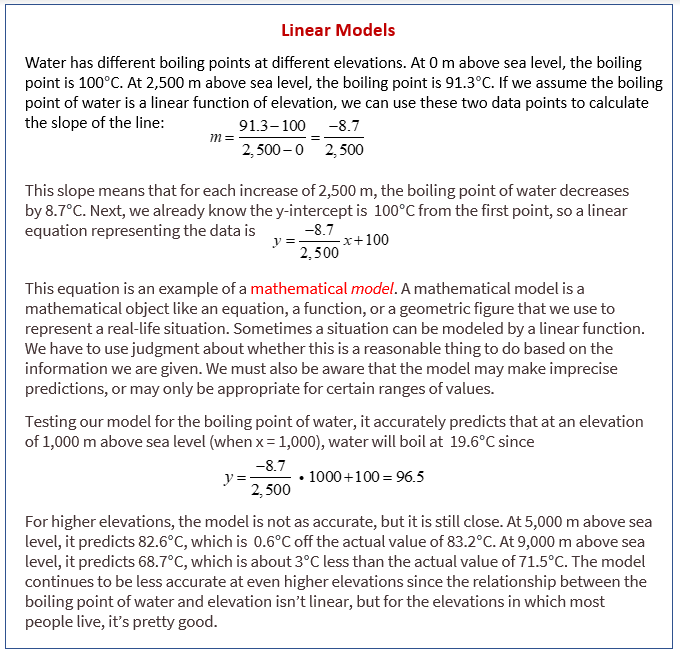Illustrative Mathematics Grade 8, Unit 5, Lesson 9: Linear Models
Learning Targets:
- I can decide when a linear function is a good model for data and when it is not.
- I can use data points to model a linear function.
Related Pages
Illustrative Math
Grade 8
Lesson 9: Linear Models
Let’s model situations with linear functions.
Illustrative Math Unit 8.5, Lesson 9 (printable worksheets)
Lesson 9 Summary
The following diagram explains when a linear function is a good model for data and when it is not.

Lesson 9.1 Candlelight
A candle is burning. It starts out 12 inches long. After 1 hour, it is 10 inches long. After 3 hours, it is 5.5 inches long.
- When do you think the candle will burn out completely?
- Is the height of the candle a function of time? If yes, is it a linear function? Explain your thinking.
This tool is here for you to use if you choose. To plot a point, type its coordinates. For example, try typing (1,2). To graph a line, type its equation. Try typing y = 2x - 3. You can delete anything by clicking on the X next to it.
Open Applet
Lesson 9.2 Shadows
When the sun was directly overhead, the stick had no shadow. After 20 minutes, the shadow was 10.5 cm long. After 60 minutes, it was 26 cm long.
- Based on this information, estimate how long it will be after 95 minutes.
- After 95 minutes, the shadow measured 38.5 cm. How does this compare to your estimate?
- Is the length of the shadow a function of time? If so, is it linear? Explain your thinking.
This tool is here for you to use if you choose. To plot a point,type its coordinates. For example, try typing (3,5). To graph a line, type its equation. Try typing y = 2x + 7. You can delete anything by clicking on the X next to it.
Lesson 9.3 Recycling
In an earlier lesson, we saw this graph that shows the percentage of all garbage in the U.S. that was recycled between 1991 and 2013.
- Sketch a linear function that models the change in the percentage of garbage that was recycled between 1991 and 1995. For which years is the model good at predicting the percentage of garbage that is produced? For which years is it not as good?
- Pick another time period to model with a sketch of a linear function. For which years is the model good at making predictions? For which years is it not very good?
Lesson 9 Practice Problems
- On the first day after the new moon, 2% of the moon’s surface is illuminated. On the second day, 6% is illuminated.
a. Based on this information, predict the day on which the moon’s surface is 50% illuminated and 100% illuminated.
b. The moon’s surface is 100% illuminated on day 14. Does this agree with the prediction you made?
c. Is the percentage illumination of the moon’s surface a linear function of the day? - In science class, Jada uses a graduated cylinder with water in it to measure the volume of some marbles. After dropping in 4 marbles so they are all under water, the water in the cylinder is at a height of 10 milliliters. After dropping in 6 marbles so they are all under water, the water in the cylinder is at a height of 11 milliliters.
a. What is the volume of 1 marble?
b. How much water was in the cylinder before any marbles were dropped in?
c. What should be the height of the water after 13 marbles are dropped in?
d. Is the volume of water a linear relationship with the number of marbles dropped in the graduated cylinder? If so, what does the slope of the line mean? If not, explain your reasoning. - Solve each of these equations. Explain or show your reasoning.
- For a certain city, the high temperatures (in degrees Celsius) are plotted against the number of days after the new year.
Based on this information, is the high temperature in this city a linear function of the number of days after the new year? - The school designed their vegetable garden to have a perimeter of 32 feet with the length measuring two feet more than twice the width.
a. Using to represent the length of the garden and to represent its width, write and solve a system of equations that describes this situation.
b. What are the dimensions of the garden?
The Open Up Resources math curriculum is free to download from the Open Up Resources website and is also available from Illustrative Mathematics.
Try out our new and fun Fraction Concoction Game.
Add and subtract fractions to make exciting fraction concoctions following a recipe. There are four levels of difficulty: Easy, medium, hard and insane. Practice the basics of fraction addition and subtraction or challenge yourself with the insane level.

We welcome your feedback, comments and questions about this site or page. Please submit your feedback or enquiries via our Feedback page.